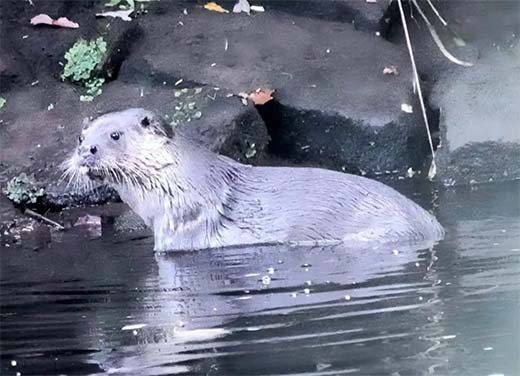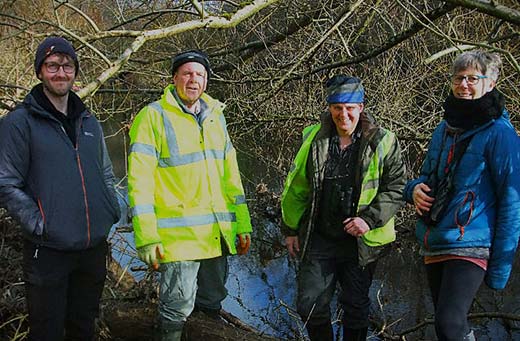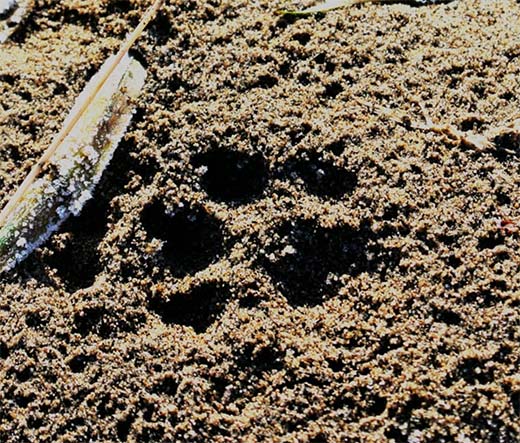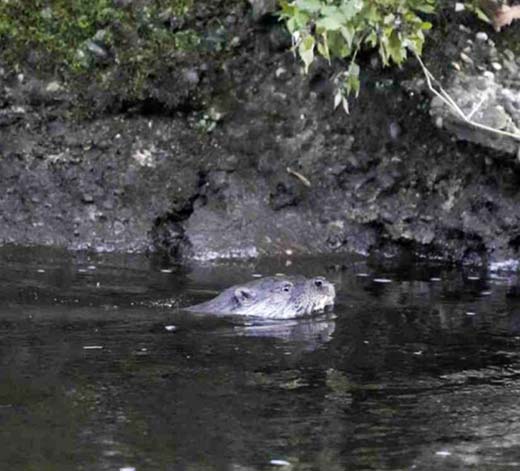Tuesday 11 February 2025
The Return of the Otter: A UK and Calderdale Conservation Success
Author - Rachel Lightbird
Eurasian otters (Lutra lutra) are among the UK's most charismatic mammals. With their cute, furry faces, curious nature, and playful antics, they endear themselves to nearly everyone – except, perhaps, some fishpond owners. Frequently featured in documentaries, nature programmes, children's literature, and folk stories, otters hold a special place in the nation's heart.

Photo: Kirsty Collins at Cromwell Bottom Nature Reserve, Oct 24
In many Celtic and Norse traditions, otters have been seen as shape-shifters or magical beings, with some Scottish legends even suggesting they could transform into humans under certain conditions. Their playful demeanour often contrasts with a deeper symbolism of survival and adaptability, qualities that appear in numerous folk tales across Europe. Otters are frequently associated with the mysterious or magical side of nature, embodying joy, whimsy and resilience.
Beyond their charm, otters are also an important indicator species for Britain's freshwater ecosystems. As top predators, they rely on an abundant food supply, including fish, small mammals, and amphibians. Therefore, if otters are thriving, it's a strong sign that the freshwater ecosystem they inhabit is likely in good health overall.
Dramatic Population Decline
Despite their popularity and ecological significance, otters faced a dramatic decline between the 1950s and 1970s due to a combination of four key threats:
- Widespread use of organochlorine pesticides – the most significant factor in their decline.
- Industrial pollution – contaminating waterways and reducing fish stocks.
- Habitat loss – particularly the canalisation of watercourses, which made rivers run faster and made it harder for otters to get out.
- Widespread hunting – further reducing populations.
These pressures decimated otter numbers, leaving only small, isolated groups in the cleaner waters of Scotland, Northumbria, Southwest England and Wales. By the late 1970s, otters in England were on the brink of extinction.
A Conservation Success Story
The good news is that otters have made a remarkable recovery since the 1970s, slowly but steadily rebuilding their populations. This progress has been documented through regular National Otter Surveys led by the Environment Agency (EA) across England every five to ten years.
In the first survey, which covered 6,000 sites across England, signs of otters were found in just 6% of locations, a stark and worrying statistic. However, by the 1990s, otters began to return to areas where they had been absent for decades. By 2010, otter signs were spotted in around 60% of surveyed sites. The latest 2022–2023 National Otter Survey of England report is currently being compiled and is expected to be released this spring.
One of the most encouraging aspects of otter recovery is that it has been almost entirely natural. Unlike other conservation efforts, such as those aimed at beavers or red squirrels, fewer than 120 captive-bred otters have been released into the wild in the UK. Instead, the otter's return has been driven primarily by legal protections, most notably the ban on harmful organochlorines like DDT, which significantly improved water quality. This was followed by habitat restoration in key areas and the introduction of hunting bans, creating a safer environment for these charismatic creatures to thrive once more.
Legal Protections and Habitat Recovery
- The Wildlife and Countryside Act 1981 made it illegal to harm, capture, or kill otters or destroy their habitats.
- The Conservation (Natural Habitats, &c.) Regulations 1994, implementing the EU Habitats Directive, provided further safeguards.
- Otters are also listed under Section 41 of the Natural Environment and Rural Communities Act 2006.
- Stricter environmental regulations, including bans on harmful chemicals like DDT, improved water quality, leading to much healthier river ecosystems.
- Habitat restoration efforts, including river rewilding, decanalisation, the removal of weirs, the addition of otter ledges to help them navigate canalised rivers and culverts, and the restoration of wetland environments, have all contributed to creating better conditions for otter populations.]
The Survey Situation in Calderdale
The English Otter Survey does include seven sites in Calderdale, all located at the western (Todmorden) end of the valley. However, no sign of otters have been found to date.
Recognising this was unlikely to be a representative picture of the entire Calderdale Catchment area, in 2021, Halifax Scientific Society mammal recorder and professional ecologist Andy Mather decided to investigate the status of otters across the borough.
Lone Otter Ranger
Andy began by reviewing historical records, which confirmed that otters had been using Calderdale's waterways in the past. However, their current status remained uncertain. Determined to fill this knowledge gap, Andy set out during lockdown to explore as many of Calderdale's waterways as possible.
Otters are territorial animals that use spraint (faeces) to mark their territory and communicate with others. To establish their presence, Andy searched for, and recorded signs such as spraint and tracks throughout the borough. His findings confirmed what he had suspected, otters were not only present in Calderdale but were actively using its waterways.

Group members at Cromwell Bottom Nature Reserve, Jan 2025
The Birth of the Calderdale Otter Project
In early 2024, Andy delivered a well-attended talk at Cromwell Bottom Nature Reserve, where several attendees expressed interest in joining him on a survey. This enthusiasm led to the formation of the Calderdale
Otter Project in early 2024
The group's first action was to commit to systematically surveying the waterways of the entire Calderdale Catchment area. Following methodologies used in national otter surveys across England and Wales, volunteers first received training in identifying spraint and tracks before conducting surveys between April and July. Over the course of the survey, they visited 38 sites across Calderdale.
Results of the 2024 Survey
The 2024 survey provided a comprehensive and representative baseline for otter distribution in Calderdale. For the purposes of the survey the Calder catchment within Calderdale was split into 19 different Environment Agency defined sub-catchments, according to their hydrological attributes. Some of its key findings include:
- Widespread Distribution: Otters are present throughout Calderdale, with signs of their activity recorded at 23 of the 38 sites surveyed (60.5%), spanning 18 of the 19 sub-catchment areas.
- River Corridor: Otter presence was most pronounced near the main river channels, indicating that these waterways serve as key movement corridors for the species.
- Gaps in Distribution: The only sub-catchment without recorded signs was the stretch between Todmorden and Cliviger.
- Low Numbers, Broad Range: While otter numbers appear relatively low, they are making use of a wide variety of habitats throughout the area.
- High-Upland Habitats: Otters are present high up in sub-catchments and near watershed areas, suggesting possible movement between different catchments.
- Diet: Spraint analysis revealed a high occurrence of crayfish in the otters' diet.

The Calderdale Otter Project: Looking Ahead
The Calderdale Otter Group is growing from strength to strength. Their plans include:
- Continued Monitoring: Ongoing surveys to track the movement and population of otters across Calderdale.
- Investigating Habitat and Diet: Research into otter habitat preferences and seasonal diet through prey remains analysis and camera trapping.
- Expanding Surveys: Extending surveys into the Colne and Holme catchments, in collaboration with the Calder and Colne Rivers Trust.
- Creating 'Otter Micro-Reserves': Identifying, mapping, and protecting key areas where otters can rest and breed—areas that offer low human disturbance, high-quality bankside habitats, and plenty of natural refugia.
- Building New Micro-Reserves: Establishing new protected areas to further support otter populations.

Photo: Kirsty Collins at Cromwell Bottom Nature Reserve, Oct 24
Final Thoughts
The widespread distribution of otters in Calderdale is a promising sign but currently it is unclear if we have a stable population. There are many threats to ongoing colonisation and otter presence in our waterways should never be taken for granted.
The Calderdale Otter Project is dedicated to monitoring and researching otters, protecting otters, habitat restorations, advocating for cleaner rivers, and educating the public about the importance of preserving these iconic animals. The project is going from strength to strength.
For further information, the full 2024 Calderdale Otter Survey report, and if you would like to join the project as a volunteer, please contact Andy at calderdaleotters@outlook.com or on 07729 548305.

